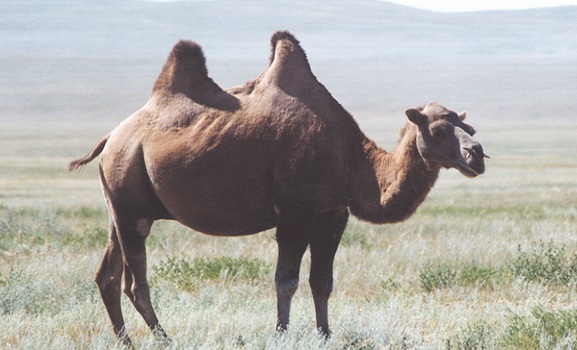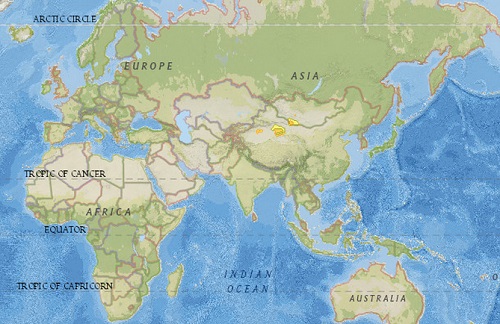
The wild Bactrian camel is listed as a Critically Endangered species by the IUCN.
Population
- According to the IUCN as of 2004 there were 600 wild Bactrian camels in China and 350 in Mongolia.
- Population trend is decreasing.
Name
- Scientific name: Camelus ferus. Camelus from the Latin camelus and the Greek Kamelos for “camel”. Ferus from the Greek word ferus meaning “savage” or “wild”.
- Common name: Mongolian wild camel, wild Bactrian camel. Bactrian from the Bactrian region of ancient Persia, modern day northern Afghanistan.
Taxonomy
- Kingdom: Animalia
- Phylum: Chordata
- Class: Mammalia
- Order: Artiodactyla
- Family: Camelidae
- Genus: Camelus
- Species: Camelus bactrianus (domestic Bactrian camel)
- Species: Camelus dromedaries (dromedary)
- Species: Camelus ferus (wild Bactrian camel)
Distribution
- The distribution of Wild Bactrian camels is restricted to 3 regions in China and 1 in Mongolia.
- China: Ganshun Gobi in Gansu, Taklimakan Desert in Xinjiang and Great Gobi Reserve.
- Mongolia: Trans Altai Gobi Desert.
Habitat
- Wild Bactrian camels live in mountains, arid plains and desert areas with sparse vegetation and scarce sources of water.
- The areas that they inhabit have large temperature fluctuations from up to 160˚F (70˚C) in the summer to -22˚F (70˚C) in the winter.
Physical Features
- Wild Bactrian camels have two pointed humps composed of fibrous tissue and fat, which serves as storage of energy when food is not available.
- Humps can disappear when the camel is near starvation.
- Camels’ nostrils have evolved to recover water from vapor they would otherwise exhale.
- Smaller than the domestic Bactrian camel.
- They have long thick eyelashes to protect eyes against sand storms.
- The coat of the wild species is lighter than that of the domesticated species.
- In the winter its coat becomes thicker and thinner in the summer.
Behavior
- Bactrian camels (Camelus Bactrianus) were domesticated 4,000 to 6,000 years ago while wild Bactrian camels (Camelus ferus) avoided domestication. It is believed that isolation could have played a role.
- Bactrian camels are extremely shy.
- They are a migratory species and travel in groups.
- Camels are ruminants and usually have four compartments in their stomachs. They Browse or graze for 6 to 8 hours a day and chew cud for another 6 to 8 hours.
- In summer camels are able to go without drinking water for 5 days. In cold weather they can forgo water for months when green feed is available.
- They can travel long distances searching for water. The wild Bactrian camel has adapted to drinking salt water which the domestic camels will not drink.
Diet
- Grass, leaves and shrubs.
Reproduction
- Female wild Bactrian camels reach reproductive maturity age 3 to 4 while males at age 5 to 6.
- Breeding peaks in February- March. Gestation period is 12 to 14 months.
- The young are born in March-April. Females give birth to one young, very rarely 2.
Life Expectancy
- The life expectancy of wild Bactrian camels is an average of 40 years.
Threats
- Wild Bactrian camels are killed for their meat.
- They are sensitive to droughts and wolf predation.
- Hybridization with domestic Bactrian camels poses a risk in the genetic strain.
- Habitat degradation due to illegal mining and livestock activity.
- Competition for grazing and water.
Conservation Status
- The wild Bactrian camel is assessed by the IUCN Red List of Threatened Species as a Critically Endangered species.
- This species is listed under Appendix I of CITES.
Interesting Facts
- The scientific name of the wild Bactrian camel, Camelus ferus, was confirmed in 2003 by the International Commission on Zoological Nomenclature and recognized by the IUCN.
- A thirsty camel can drink up to 200 liters of water in one day.
References and further research
IUCN Red List of Threatened Species – Camelus ferus
World Association of Zoos and Aquariums – WASA – Bactrian camel (camelus ferus)
San Diego Zoo Library – Bactrian and Dromedary Camels
Wild Camel Protection Foundation

